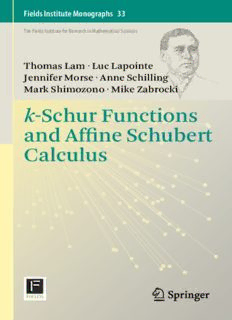
k-Schur Functions and Affine Schubert Calculus PDF
Preview k-Schur Functions and Affine Schubert Calculus
Fields Institute Monographs 33 The Fields Institute for Research in Mathematical Sciences Thomas Lam · Luc Lapointe Jennifer Morse · Anne Schilling Mark Shimozono · Mike Zabrocki k-Schur Functions and Affi ne Schubert Calculus Fields Institute Monographs Volume 33 The Fields Institute for Research in Mathematical Sciences FieldsInstituteEditorialBoard: CarlR.Riehm,ManagingEditor EdwardBierstone,DirectoroftheInstitute MatheusGrasselli,DeputyDirectoroftheInstitute JamesG.Arthur,UniversityofToronto KennethR.Davidson,UniversityofWaterloo LisaJeffrey,UniversityofToronto BarbaraLeeKeyfitz,OhioStateUniversity ThomasS.Salisbury,YorkUniversity NorikoYui,Queen’sUniversity TheFieldsInstituteisacentreforresearchinthemathematicalsciences,locatedin Toronto,Canada.TheInstitutesmissionistoadvanceglobalmathematicalactivity intheareasofresearch,educationandinnovation.TheFieldsInstituteissupported bytheOntarioMinistryofTraining,CollegesandUniversities,theNaturalSciences and Engineering Research Council of Canada, and seven Principal Sponsoring Universities in Ontario (Carleton, McMaster, Ottawa, Toronto, Waterloo, Western andYork),aswellasbyagrowinglistofAffiliateUniversitiesinCanada,theU.S. andEurope,andseveralcommercialandindustrialpartners. Forfurthervolumes: http://www.springer.com/series/10502 Thomas Lam • Luc Lapointe • Jennifer Morse Anne Schilling • Mark Shimozono Mike Zabrocki k-Schur Functions and Affine Schubert Calculus 123 TheFieldsInstituteforResearch intheMathematicalSciences ThomasLam LucLapointe DepartmentofMathematics InstitutodeMatemáticayFísica UniversityofMichigan UniversidaddeTalca AnnArbor,MI,USA Talca,Chile JenniferMorse AnneSchilling DepartmentofMathematics DepartmentofMathematics DrexelUniversity UniversityofCalifornia Philadelphia,PA,USA Davis,CA,USA MarkShimozono MikeZabrocki DepartmentofMathematics MathematicsandStatistics VirginiaTech YorkUniversity Blacksburg,VA,USA Toronto,ON,Canada ISSN1069-5273 ISSN2194-3079(electronic) ISBN978-1-4939-0681-9 ISBN978-1-4939-0682-6(eBook) DOI10.1007/978-1-4939-0682-6 SpringerNewYorkHeidelbergDordrechtLondon LibraryofCongressControlNumber:2014934668 MathematicsSubjectClassification(2010):05E05,05E10,14R99,14N15,14N35 ©SpringerScience+BusinessMediaNewYork2014 Thisworkissubjecttocopyright.AllrightsarereservedbythePublisher,whetherthewholeorpartof thematerialisconcerned,specificallytherightsoftranslation,reprinting,reuseofillustrations,recitation, broadcasting,reproductiononmicrofilmsorinanyotherphysicalway,andtransmissionorinformation storageandretrieval,electronicadaptation,computersoftware,orbysimilarordissimilarmethodology nowknownorhereafterdeveloped.Exemptedfromthislegalreservationarebriefexcerptsinconnection with reviews or scholarly analysis or material supplied specifically for the purpose of being entered and executed on a computer system, for exclusive use by the purchaser of the work. Duplication of this publication or parts thereof is permitted only under the provisions of the Copyright Law of the Publisher’slocation,initscurrentversion,andpermissionforusemustalwaysbeobtainedfromSpringer. PermissionsforusemaybeobtainedthroughRightsLinkattheCopyrightClearanceCenter.Violations areliabletoprosecutionundertherespectiveCopyrightLaw. Theuseofgeneraldescriptivenames,registerednames,trademarks,servicemarks,etc.inthispublication doesnotimply,evenintheabsenceofaspecificstatement,thatsuchnamesareexemptfromtherelevant protectivelawsandregulationsandthereforefreeforgeneraluse. While the advice and information in this book are believed to be true and accurate at the date of publication,neithertheauthorsnortheeditorsnorthepublishercanacceptanylegalresponsibilityfor anyerrorsoromissionsthatmaybemade.Thepublishermakesnowarranty,expressorimplied,with respecttothematerialcontainedherein. Coverillustration:DrawingofJ.C.FieldsbyKeithYeomans Printedonacid-freepaper SpringerispartofSpringerScience+BusinessMedia(www.springer.com) Contents 1 Introduction .................................................................. 1 Appendix:SAGE............................................................... 6 2 Primeronk-SchurFunctions .............................................. 9 1 BackgroundandNotation ............................................... 10 1.1 PartitionsandCores.............................................. 10 1.2 Bounded Partitions, Cores, and Affine GrassmannianElements ......................................... 14 1.3 WeakOrderandHorizontalChains ............................. 22 1.4 Cores and the Strong Order of the Affine SymmetricGroup ................................................ 26 1.5 SymmetricFunctions ............................................ 31 1.6 SchurFunctions.................................................. 34 1.7 Hall–LittlewoodSymmetricFunctions.......................... 37 1.8 MacdonaldSymmetricFunctions ............................... 39 1.9 EmpiricalApproachtok-SchurFunctions...................... 43 1.10 NotesonReferences ............................................. 47 2 FromPieriRulestok-SchurFunctionsatt D1....................... 47 2.1 Semi-standard Tableaux and a Monomial ExpansionofSchurFunctions................................... 48 2.2 Weak Tableaux and a Monomial Expansion ofDualk-SchurFunctions....................................... 51 2.3 OtherRealizations................................................ 57 2.4 Strong Marked Tableaux and a Monomial Expansionofk-SchurFunctions ................................ 60 2.5 k-Littlewood–RichardsonCoefficients.......................... 66 2.6 NotesonReferences ............................................. 70 3 Definitionsofk-SchurFunctions ....................................... 71 3.1 AtomsasTableaux............................................... 71 3.2 ASymmetricFunctionOperatorDefinition .................... 77 3.3 WeakTableauxII................................................. 79 v vi Contents 3.4 StrongTableauxII ............................................... 83 3.5 NotesonReferences ............................................. 86 4 Propertiesofk-SchurFunctionsandTheirDuals...................... 87 4.1 k-SchurFunctionsAreSchurFunctionsWhen k (cid:2)j(cid:2)jandWhent D0......................................... 87 4.2 Thek-SchurFunctionIsSchurPositive ........................ 88 4.3 Att D1,thek-SchurFunctionsSatisfythek-PieriRule ..... 89 4.4 k-Conjugation.................................................... 91 4.5 Thek-SchurFunctionsFormaBasisforƒt .................. 92 .k/ 4.6 Thek-RectangleProperty ....................................... 93 4.7 Whent D 1,theProductofk-SchurFunctions Isk-SchurPositive............................................... 94 4.8 PositivelyClosedUnderCoproduct............................. 94 4.9 TheProductofak-Schurand`-SchurFunction Is.kC`/-SchurPositive........................................ 96 4.10 BranchingPropertyfromktokC1............................ 96 4.11 k-SchurPositivityofMacdonaldSymmetricFunctions ....... 98 5 DirectionsofResearchandOpenProblems............................ 99 5.1 Ak–Murnaghan-NakayamaRule............................... 99 5.2 ARectangleGeneralizationatt aRootofUnity............... 101 5.3 ADual-Basistos.k/ŒXIt(cid:3) ....................................... 102 (cid:2) 5.4 AProductonƒt ................................................ 105 .k/ 5.5 ARepresentationTheoreticModelofk-SchurFunctions ..... 107 5.6 FromPieritoK-Theoretick-SchurFunctions ................. 109 6 DualityBetweentheWeakandStrongOrders......................... 112 6.1 k-AnalogueoftheCauchyIdentity ............................. 113 6.2 ABriefIntroductiontoFomin’sGrowthDiagrams ............ 115 6.3 AffineInsertion................................................... 118 6.4 Thet-CompatibleAffineInsertionAlgorithm.................. 125 7 Thek-ShapePosetandaBranchingRuleforExpressing k-Schurin(kC1)-SchurFunctions.................................... 126 3 StanleySymmetricFunctionsandPetersonAlgebras................... 133 1 StanleySymmetricFunctionsandReducedWords.................... 134 1.1 YoungTableauxandSchurFunctions........................... 135 1.2 PermutationsandReducedWords............................... 135 1.3 ReducedWordsfortheLongestPermutation................... 136 1.4 TheStanleySymmetricFunction................................ 136 1.5 TheCodeofaPermutation ...................................... 137 1.6 FundamentalQuasi-symmetricFunctions ...................... 138 1.7 Exercises.......................................................... 138 2 Edelman-GreeneInsertion............................................... 139 2.1 InsertionforReducedWords .................................... 139 2.2 Coxeter-KnuthRelations......................................... 141 2.3 ExercisesandProblems.......................................... 141 Contents vii 3 AffineStanleySymmetricFunctions ................................... 144 3.1 AffineSymmetricGroup......................................... 144 3.2 Definition......................................................... 144 3.3 Codes ............................................................. 145 3.4 ƒ andƒ.n/ ..................................................... 146 .n/ 3.5 AffineSchurFunctions .......................................... 146 3.6 Example:TheCaseofSQ ........................................ 147 3 3.7 ExercisesandProblems.......................................... 147 4 RootSystemsandWeylGroups......................................... 149 4.1 NotationforRootSystemsandWeylGroups................... 149 4.2 AffineWeylGroupandTranslations............................ 150 5 NilCoxeterAlgebraandFomin-StanleyConstruction................. 151 5.1 TheNilCoxeterAlgebra ......................................... 151 5.2 FominandStanley’sConstruction............................... 152 5.3 AConjecture ..................................................... 153 5.4 ExercisesandProblems.......................................... 155 6 TheAffineNilHeckeRing .............................................. 155 6.1 DefinitionofAffineNilHeckeRing............................. 156 6.2 Coproduct......................................................... 157 6.3 ExercisesandProblems.......................................... 158 7 Peterson’sCentralizerAlgebras......................................... 158 7.1 PetersonAlgebraandj-Basis................................... 158 7.2 SketchProofofTheorem7.3.................................... 159 7.3 ExercisesandProblems.......................................... 160 8 (Affine)Fomin-StanleyAlgebras ....................................... 161 8.1 CommutationDefinitionofAffineFomin-StanleyAlgebra.... 161 8.2 Noncommutativek-SchurFunctions............................ 162 8.3 CyclicallyDecreasingElements................................. 163 8.4 Coproduct......................................................... 164 8.5 ExercisesandProblems.......................................... 165 9 FiniteFomin-StanleySubalgebra....................................... 165 9.1 Problems.......................................................... 167 10 GeometricInterpretations ............................................... 167 4 AffineSchubertCalculus.................................................... 169 1 Introduction.............................................................. 169 2 RootData................................................................. 171 2.1 CartanDataandtheWeylGroup................................ 171 2.2 RootData......................................................... 173 2.3 AffineRootData ................................................. 176 3 NilHeckeRingandSchubertCalculus.................................. 179 3.1 NilHeckeRing.................................................... 180 3.2 CoproductonA .................................................. 184 3.3 DualityandtheGKMRing...................................... 187 3.4 MultiplicationinƒandCoproductinA........................ 191 viii Contents 3.5 ForgettingEquivariance.......................................... 192 3.6 ParabolicCase.................................................... 193 3.7 GeometricInterpretations........................................ 194 4 AffineGrassmannian .................................................... 196 4.1 AffineGrassmannianasPartialAffineFlags ................... 197 4.2 SmallTorusVersionofƒ ...................................... 198 af 4.3 HomologyoftheAffineGrassmannian......................... 199 4.4 SmallTorusAffineNilHeckeRingandPetersonSubalgebra.. 200 4.5 Thej-Basis....................................................... 203 4.6 HomologyStructureConstants.................................. 205 4.7 Peterson’s“QuantumEqualsAffine”Theorems................ 205 A Appendix:ProofofCoalgebraProperties .............................. 206 B Appendix:SmallTorusGKMProofs................................... 208 b B.1 SmallTorusGKMConditionforsl ............................ 210 2 C Appendix:HomologyofGr............................................. 212 Bibliography...................................................................... 213 Chapter 1 Introduction Affine Schubert calculus is a subject that lies at the crossroads of combinatorics, geometry, and representation theory. Its modern development is motivated by two seemingly unrelated directions. One is the introduction of k-Schur functions in the study of Macdonald polynomial positivity, a mostly combinatorial branch of symmetricfunctiontheory.TheotherdirectionisthestudyoftheSchubertbasesof the (co)homology of the affine Grassmannian, an algebro-topological formulation ofaprobleminenumerativegeometry. Classical Schubert calculus is a branch of enumerative algebraic geometry concernedwithproblemsoftheform: HowmanylinesLin3-spaceintersectfourfixedlinesL ;L ;L ;L ? 1 2 3 4 In general, lines are replaced by affine linear subspaces, and conditions on the dimensions of intersections are imposed. When L ;L ;L ;L are in generic 1 2 3 4 position,theanswertotheaboveproblemistwo;thisisapleasantsurprise,sincein linearalgebraoneexpectstofind0;1,or1solutions.Schubert[144]studiedsuch “Schubertproblems”inthenineteenthcentury.Attheturnofthetwentiethcentury, Hilbertposedashis15thproblemtherigorousfoundationofSchubert’senumerative calculus.SubsequentdevelopmentsingeometryandtopologyconvertedsuchSchu- bertproblemsintoproblemsofcomputationinthecohomologyringH(cid:2).Gr.k;n// of the Grassmannian Gr.k;n/ of k-planes inn-space. The problems were reduced tofindingstructureconstants,nowcalledLittlewood-Richardsoncoefficients[118], ofacertain“Schubertbasis”forH(cid:2).Gr.k;n//. TheexplicitrealizationofthesecomputationsusingthetheoryofSchurfunctions played an important role in transforming Schubert calculus into a contemporary theory that stretches into many fields. The Schur functions s form a basis for the (cid:2) symmetricfunctionspaceƒandattheturnofthecentury,itwasdiscoveredthatthey matchirreduciblerepresentationsofthesymmetricgroup.Later,adeepconnection betweenSchurfunctionsandthegeometryofGrassmannianswasestablishedwhen itwasshownthattheSchubertstructureconstantsexactlyequalcoefficientsinthe product of Schur functions in ƒ. The rich combinatorial backbone of the theory T.Lametal.,k-SchurFunctionsandAffineSchubertCalculus,FieldsInstitute 1 Monographs33,DOI10.1007/978-1-4939-0682-6__1, ©SpringerScience+BusinessMediaNewYork2014
Description: